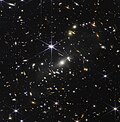 Artist's rendering of LHS 475b | |
| Discovery | |
|---|---|
| Discovered by | James Webb Space Telescope |
| Discovery date | 2023 |
| Transit | |
| Orbital characteristics [1] | |
| 2.0291±0.0000 d | |
| Star | LHS 475 |
| Physical characteristics [1] | |
| 0.99±0.05 R🜨 | |
| Mass | 0.91±0.19 M🜨 |
| Temperature | 586 K (313 °C , 595 °F ) |
LHS 475 b is a terrestrial planet orbiting the star LHS 475 which is about 40.7 light years away, in the constellation of Octans. [2] [3] It was the first extrasolar planet to be confirmed by the James Webb Space Telescope. [4] It completes an orbit every 2 days and is 99% the diameter of Earth. It is also one of the most similar-to-Earth exoplanets discovered, in terms of radius. [5]




